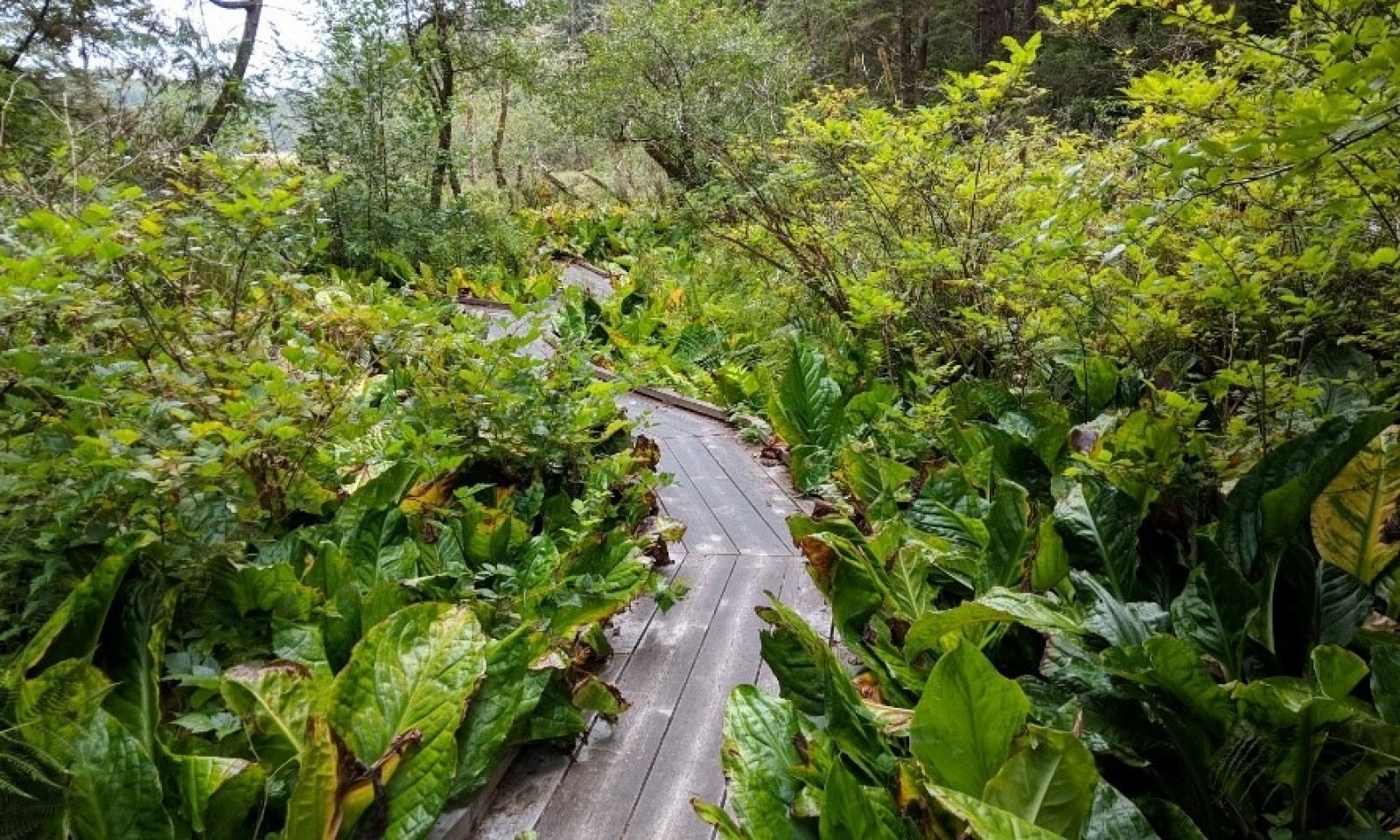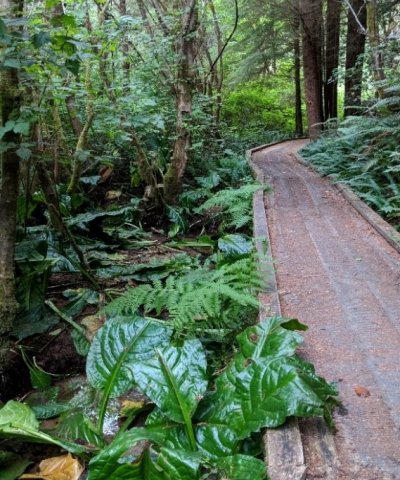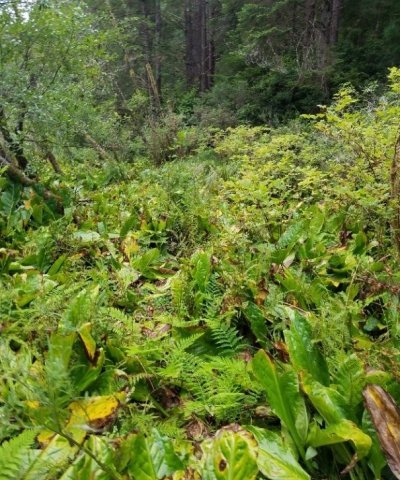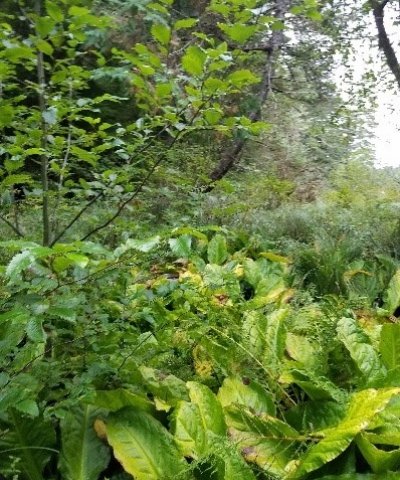

Natural Resources
Conservation Service
Ecological site F004AC013OR
Aquic Flood Plain Forest
Last updated: 1/23/2025
Accessed: 03/14/2025
General information
Provisional. A provisional ecological site description has undergone quality control and quality assurance review. It contains a working state and transition model and enough information to identify the ecological site.
MLRA notes
Major Land Resource Area (MLRA): 004A–Sitka Spruce Belt
This resource area is along the coast of the Pacific Ocean. It is characterized by a marine climate and coastal fog belt. The parent material is primarily glacial, marine, or alluvial sediment and some scattered areas of Tertiary sedimentary rock and organic deposits. Glacial deposits are dominant in the northern part of the MLRA in Washington; marine and alluvial deposits and eolian sand are dominant along the southern part of the Washington coast and extending into Oregon. The mean annual precipitation ranges from 52 to 60 inches near the beaches to more than 190 inches in the inland areas of the MLRA.
Andisols and Inceptisols are the dominant soil orders in the MLRA, but Spodosols, Entisols, and Histosols are also present. The soils are shallow to very deep and very poorly drained to somewhat excessively drained. They are on hilly marine terraces and drift plains; coastal uplands, hills, and foothills; flood plains; and coastal dunes, marshes, and estuaries.
The soil temperature regimes of MLRA 4A are moderated by the proximity to the Pacific Ocean, which eases the differences between the mean summer and winter temperatures. The seasonal differences in temperature are more pronounced in adjacent MLRAs further inland. Included in MLRA 4A are soils in cooler areas at higher elevations or on northerly aspects that have an isofrigid temperature regime.
The soil moisture regimes of MLRA 4A are typified by soils that do not have an extended dry period during normal years. Many of the soils further inland in MLRA 2 have a dry period in summer. Soils in low-lying areas and depressions of MLRA 4A are saturated in the rooting zone for extended periods due to a high water table or long or very long periods of flooding or ponding.
MLRA 4A Soil Temperature Regimes
Isomesic The mean annual soil temperature (measured at a depth of 20 inches) is 46 to 59 degrees F, and the difference between the mean winter and summer temperatures is less than 11 degrees. The seasonal soil temperatures and difference between the mean winter and summer temperatures are moderated by the proximity to the ocean and the effects of fog in summer.
Isofrigid The mean annual soil temperature (measured at a depth of 20 inches) is 32 degrees F to less than 46 degrees, and the difference between the mean winter and mean summer temperatures is less than 11 degrees. The seasonal soil temperatures and difference between the mean winter and summer temperatures are moderated by the proximity to the ocean and the effects of fog in summer. The temperatures are cooler than in surrounding lowlands because of the higher elevation and differences in slope and aspect.
MLRA 4A Soil Moisture Regimes
Udic The soil rooting zone is not dry in any part for more than 90 cumulative days in normal years. Soil moisture does not limit plant growth because of the fog in summer.
Aquic The soil is virtually free of dissolved oxygen due to saturation of the rooting zone. The soils are saturated for extended periods during the growing season and may be subject to long or very long periods of ponding and flooding.
Refer to Keys to Soil Taxonomy for complete definitions of the soil temperature and moisture regimes.
LRU notes
The Southern Sitka Spruce Belt land resource unit (LRU C) of MLRA 4A is along the west coast of Oregon. This LRU extends from the northern edge of South Slough to the Chetco River, and it is bounded on the west by the Pacific Ocean. The area consists of sand dunes, flood plains, and marine terraces that extend a few miles east and are parallel to the Pacific Ocean, and it transitions to steeper, higher elevation ridges and foothills of the western slopes of the Coast Range. The soils in the coastal lowland areas dominantly formed in eolian (wind-deposited) sand, alluvium, and marine sediment. The soils in the coastal foothills formed in residuum, colluvium, and landslide deposits derived from sedimentary and basaltic rock. Minor additions of recent alluvium are along the river valleys. Several major rivers that have headwaters in the coastal mountains carved steep, narrow valleys through the foothills before entering the broader coastal valleys. Subduction zones along the Pacific Coast may cause significant earthquakes and tsunamis, which would disrupt the ecological processes beyond what is described in this ecological site description.
Classification relationships
National vegetation classification: G256 Vancouverian North Pacific Maritime Swamp Group; A3756 Swamp Forest Alliance
Plant associations of the Oregon Dunes National Recreation Area: Sitka Spruce Saturated Forest Alliance; Red Alder Saturated Forest Alliance
Ecological site concept
This ecological site is on the western coastline of the Pacific Northwest, from central to southern Oregon. It is at low elevations (less than 1,500 feet) that receive abundant precipitation and persistent fog in summer. The site is in depressions, oxbows, and backswamps of flood plains that are subject to ponding and flooding. Ponding typically occurs in October through May. Flooding occurs dominantly in November through April, but it may occur throughout the year in some areas near active rivers or stream channels.
The maritime climate is characterized by cool, moist summers and cool, wet winters. The mean annual precipitation is 55 to 130 inches. Coastal fog provides supplemental moisture in summer. The mean annual air temperature is 50 to 55 degrees F. The mild temperatures and long growing season result in highly productive forestland.
The soils that support this ecological site are in the isomesic soil temperature regime and aquic soil moisture regime. These mineral soils have a seasonal high water table and are poorly drained. They typically are very deep and formed in fine or fine-silty alluvium. These soils are dominantly Entisols or weakly developed Inceptisols due to their young age and periodic deposition of new alluvium from flooding. The seasonal high water table and ponding dynamics may be altered by artificial drainage of the site or adjacent areas.
The most common overstory species are Sitka spruce (Picea sitchensis) and red alder (Alnus rubra). Other tree species such as western hemlock (Tsuga heterophylla) and Port Orford cedar (Chamaecyparis lawsoniana) may be present, but they may be restricted to nurse logs or higher microsites. The canopy cover commonly is less than 50 percent, which provides for robust understory due to the abundant sunlight. Common understory species include twinberry (Lonicera involucrata), American skunkcabbage (Lysichiton americanus), salmonberry (Rubus spectabilis), common ladyfern (Athyrium filix-femina), and slough sedge (Carex obnupta). This ecological site closely resembles the Aquic Flood Plain Forest (F04AB007OR) site in LRU B; but the productivity of this site is higher because of the warmer, longer growing season.
The most common natural disturbances are ponding and flooding. The volume and longevity of the disturbance determine the effect on the dynamics of the forest. Minor flooding and ponding events may affect the understory through minor scouring and sediment deposition but leave the overstory essentially intact. The trees are particularly susceptible to windthrow following large coastal storms due to the shallow rooting depth in response to the seasonal high water table and long periods of ponding that extend into the growing season. Fallen trees that have exposed root systems and large woody debris are common. As the interval between disturbances extends, the overstory becomes more diverse due to conifer establishment. Logging activities in adjacent uplands may alter the hydrology of those areas, which may increase susceptibility to infestation by invasive species. In the absence of disturbance, it is expected that maturation and succession will result in an old-growth conifer forest.
Table 1. Dominant plant species
| Tree |
(1) Picea sitchensis |
|---|---|
| Shrub |
(1) Rubus spectabilis |
| Herbaceous |
(1) Lysichiton americanus |
Click on box and path labels to scroll to the respective text.




